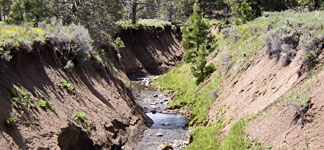|
|||||
� |
Resource Concerns >> Aquatic/Wildlife Habitat |
||||||||||
|
Aquatic/Wildlife Habitat |
||||||||||
Existing Conditions and Assessment ConclusionsOne of the most valuable resources within the Pit RCD area is open space allowing for quality and quantity of habitat for fish and other aquatic species, waterfowl, and a wide variety of game and non-game wildlife species. In a state of 30 million people and growing, this is a valuable and shrinking resource. Past and current land management (irrigation agriculture, logging, grazing, roads, fire control, etc) have impacted habitat conditions in both positive and negative ways. However, due mainly to the large and undeveloped nature of the landscape, habitat value remains high and there are many opportunities to improve this condition. The 14,000 acre state owned Ash Creek Wildlife Area is of particular significance with regard to habitat quality and quantity. Extensive riparian areas and wet meadows on both public and private lands are also important habitat features. Healthy conditions in the sagebrush steppe, juniper, aspen and conifer stands are important for a wide variety of terrestrial species. Irrigated pasture, hay fields, and other crop lands provide food, cover, and resting area for species such as mule deer, pronghorn, sandhill cranes, and bald eagles. The RCD will strive to protect and enhance open space and habitat quality in the District. Management StrategyA. The RCD will promote the continued open space, agricultural nature of the landscape based on its value for habitat quality and quantity. Efforts to convert lands to other ‘development’ oriented uses will be discouraged. B. Farm Bill programs such as WRP, CRP, CSP and EQIP will be supported through technical and financial assistance, Community education, and outreach activities will emphasize habitat value and will discuss options for habitat preservation or enhancement (e.g. conservation easements). C. The RCD will continue in a partnership with the Dept. of Fish and Game to see that the Ash Creek Wildlife Area is managed in a way that uses production agriculture to contribute to the waterfowl and wildlife habitat value of this property. D. The RCD will partner with agencies and landowners to improve upland vegetation conditions in a way that improves habitat quality and quantity. Management options include grazing management, fire, road restrictions, and removal of undesired vegetation species. |
Ash Creek Wildlife Area.Deer in a pasture near the Pit River. |
||||||||||
